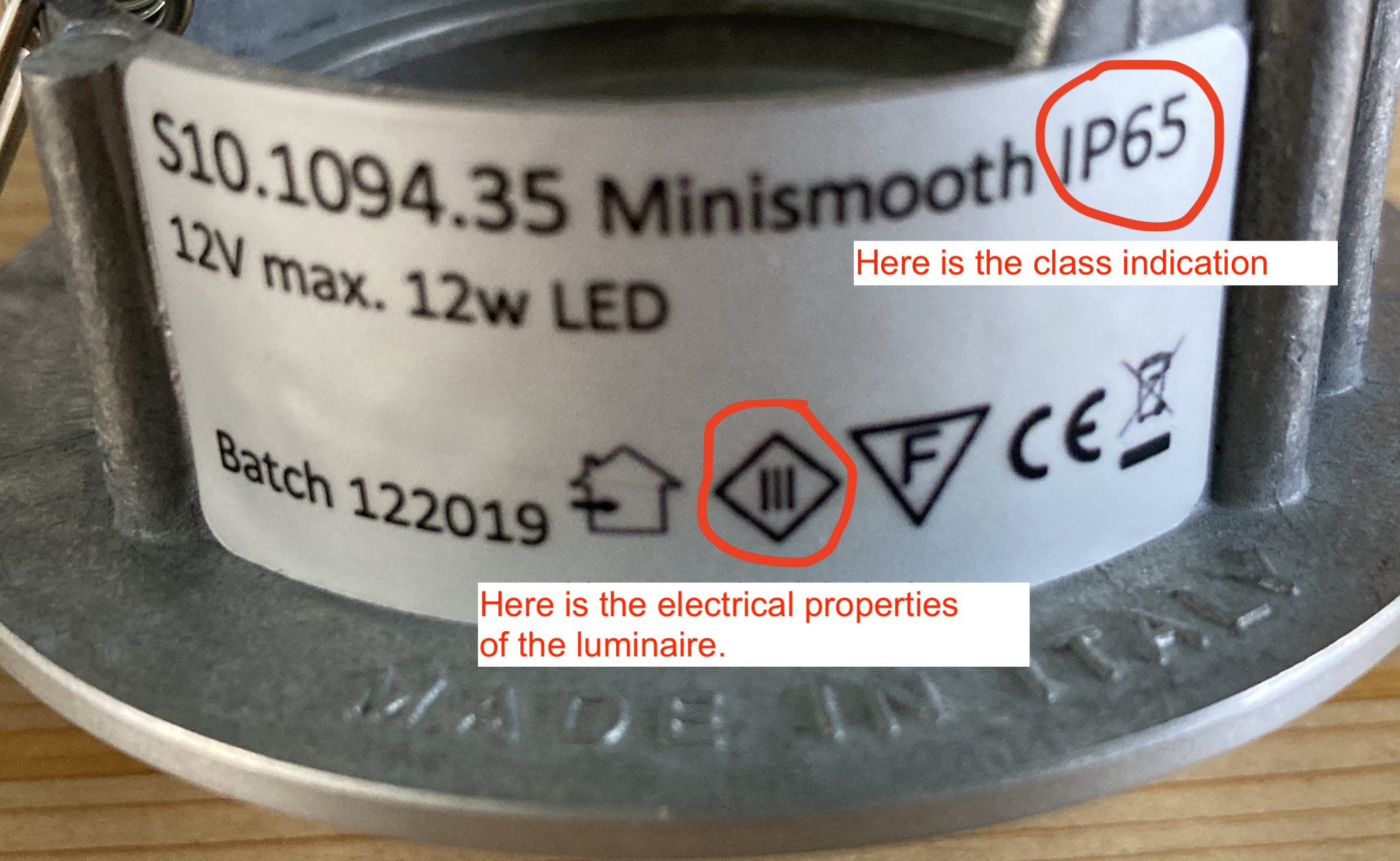Explanation IP/ bathroom zones
Explanation IP/ bathroom lighting
If you are going to renovate or refurbish your bathroom, you should also think about the lighting.
And due to the presence of water vapor, water splashes and water jets, bathroom lighting requires meeting a certain requirement to be considered safe. In this blog I explain how and where and which lighting can be placed.
We must pay attention to 2 points:
1.The IP class, how dust and waterproof is the fixture.
2.The electrical properties of the fixture.

These properties are indicated on the fixture or on the packaging. Below is a photo of a label with the IP class and electrical properties.
We start with the IP Class:
This certification is referred to simply as ‘Ingress Protection’ or IP classification. This gives a fixture an appreciation based on two factors.
A classification is displayed as the letters ‘IP’ followed by two numbers, as an example the IP rating is ‘IP44’, see table below. The first digit refers to the resistance of solids. IP4X protected against objects larger than 1mm in diameter.
The second digit refers to the resistance of liquids. IPX4 protected from splashing water.
Below this table, we will continue with the explanation of where to apply which IP rating in the bathroom.
Object and dust protection (1st IP digit)
IP 0X - not protected
IP 1X - protected against objects larger than 50mm in diameter
IP 2X - protected against objects larger than 12mm in diameter
IP 3X - protected against objects larger than 2.5mm in diameter
IP 4X - protected from objects larger than 1mm in diameter
IP 5X - dust protected
IP 6X - dustproof
Protection against water (2nd IP digit)
IP X0 - not protected
IP X1 - protected from dripping water
IP X2 - protected from dripping water at an inclin position of up to 15 degrees
IP X3 - protected from spraying water
IP X4 - protected from splashing water
IP X5 - protected from water jets
IP X6 - protected from downpours
IP X7 - immersion protected (30 minutes to 1 meter deep)
Where are you going to place the bathroom lighting?
A zone layout has been made for placing lighting in the bathroom. Here you can find out which IP rating the bathroom fixture must meet, see the drawing below.
Zone 0: This is on the inside of the bath or shower tray, do not place lighting fixtures here.
- Zone1: This is above the shower and above the bath. Here you place an IP65 fixture or with a higher IP rating. Please note that in zone 1 you apply a low-voltage luminaire, class 111 (for example 12/24volt). If your ceiling above zone 1 is higher than 225cm (measured from the bottom of the bath or shower tray) you can also use an IP44 fixture, but IP65 fixture is recommended.
- Zone 2: This is up to 60cm from zone 1, here you place an IP44 fixture or a higher IP rating. You can use a class 1, 2 or 3 fixture here. Here you can quietly use a GU10 230v lamp in combination with an IP44 (or higher) fixture. If your ceiling above zone 1 is higher than 225cm (measured from the bottom of the bath or shower tray), this also falls under zone 2.
- Zone 3: Is from a distance of at least 0.6 meters from a bath or shower tray. Minimum illumination with IP21 or higher IP rating and class I, II or III. There is still a lot of moisture in this zone. Think of water vapor.
Explanation of the class designation / electrical properties
Class I: Grounded luminaire 230 volts. This fixture needs to be grounded! When there is a closure in this fixture, the earth leak switch immediately knocks out.

Class II: Double insulated luminaire 230 volts. With this luminaire, all electrical parts are double insulated. This fixture Should never be grounded with this the double insulation expires.

Class III: Extra low safety voltage. The luminaire has a transformer or an LED driver that comes out of low voltage. There must also be a special low-voltage plug between the driver and the fixture. Due to the low safety voltage, this is a very safe fixture and therefore it can also be placed in zone I in the bathroom. If there is ever a short circuit in this fixture, switch off the device, and you grab it while taking a shower, nothing will happen.

If you have this prior knowledge, then we can now choose a fixture suitable for the right areas in the bathroom.
You can also install different fixtures, for example an LED recessed downlight IP65 above the shower and then a ceiling light IP21 in the middle of the bathroom in zone 3.
If you can't figure it out yourself, it's better to call in an authorized installer! This way you are assured of safe installation and a beautifully lit bathroom!
And don't forget to look at our bathroom lighting.




